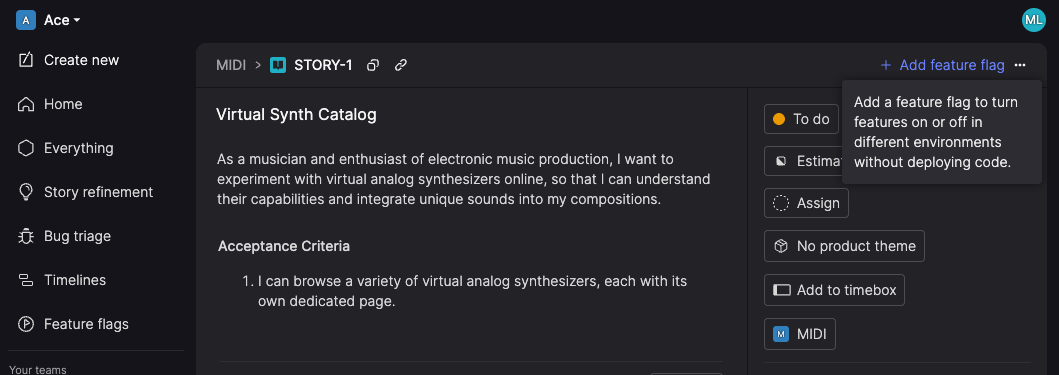Feature flags are a powerful tool for controlled rollouts, A/B testing, and risk management. Flags enable teams to release features gradually, test new ideas, and quickly disable problematic ones. But when feature flags are managed separately from the work they control, it creates unnecessary complexity.
Teams have to cross-reference flags with stories, switch between tools, and manually align on which flags are active. This makes it difficult for product managers, developers, and QA to stay in sync, increasing the risk of errors during testing and rollouts. Over time, untracked and forgotten flags can clutter the codebase, adding long-term maintenance challenges.
The key takeaway here is simple: feature flags shouldn’t be an afterthought. They need to be baked into the development process from the start.
Embedding feature flags into stories
In many systems, feature flags are managed separately, forcing teams to cross-reference them with the functionality they control. This adds complexity and slows down the process, requiring teams to juggle multiple platforms.
Atono takes a different approach. We embed feature flags directly into the stories you’re working on, so you can toggle features on or off right within your workflow. This connection provides clarity on which features are enabled or being tested, all tied to the specific context of the work. It’s a unique feature that sets us apart from the competition—and it eliminates the need to maintain a separate feature flag system.
Here’s why we made this choice:
Reduced risk of errors
Linking feature flags to stories makes it easy for everyone on the team to see which features are enabled. Developers, product managers, and QA can track progress and stay aligned without any confusion about which items are controlled by flags. This visibility reduces the risk of mistakes and ensures that everyone is on the same page.
Clear ownership, better collaboration
With flags embedded into stories, product owners can define the expected behavior and flip the flag when it’s ready. Developers focus on implementation. Both sides are clear on what the flag controls because it’s right there in the story. That clarity helps teams move faster with fewer handoffs and less miscommunication.
One less system to manage
Atono eliminates the need for a separate feature flag system. There’s no extra platform to maintain, no additional user accounts to manage, and no switching between tools to track what’s happening. Everything you need to manage feature flags is built into your workflow, making it simple for teams to stay aligned.
Better context for debugging
When feature flags are tied to user stories, QA can quickly see which features are active in an environment, improving the debugging process. If an issue arises, knowing which flags are on makes it easier to identify the root cause, without sifting through logs or external tools. With this clear visibility, teams can troubleshoot faster, minimizing downtime and reducing the impact of bugs on users.
Reduce risk of feature flag sprawl
Flag sprawl happens when teams create flags but fail to track or remove them. Embedding feature flags in stories prevents this by tying each flag to a specific story, making it easier to manage its lifecycle. The feature’s status stays visible in one place as it progresses through development and testing. Once the feature is fully released, the flag can be removed as part of the story, keeping the codebase clean and free from unnecessary clutter.
Lightweight, intuitive flag management
Atono’s flag interface is simple and easy to maintain. Anyone with access to a story can add a flag, while only users with the right permissions can modify details, turn features on and off, or remove flags. Compared to traditional feature flag systems, Atono’s built-in approach is more intuitive, reducing the learning curve and making it easier for teams to manage flags without switching between platforms.
Even better, Atono’s browser extension lets you flip feature flags right from your application. This lets you toggle a feature on or off while using your application—without ever leaving the context of the work. It’s especially useful for fast rollbacks when something goes wrong or for managing flags during live testing. The extension was designed with a clear purpose—to improve how you manage feature flags and report bugs.
Feature flags at their best
With Atono, we integrate feature flags directly into stories, making them part of your core development flow. This approach keeps teams aligned, streamlines debugging, and eliminates the need for a separate feature flag system. It also gives everyone on the team the power to manage flags, all while maintaining control.
Feature flags are a powerful tool, and Atono makes sure they’re treated as such.




